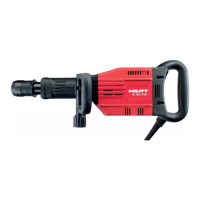13
en
4. Technical data
Tool TE 905-AVR
Rated power input 1550 W 1600 W 1550 W 1600 W 1600 W 1600 W
Rated voltage 100 V 110 V 120 V 220 V 230 V 240 V
Rated current input 15 A 16 A 13 A 8.2 A 8.3 A 8.3 A
Mains frequency 50–60 Hz
Weight of tool 11.3 kg
Dimensions (l×w×h) 680×110×240 mm
Chuck TE-S
Hammering speed under load 2200 blows/min
Single impact energy 20 joules
Chiseling performance in medium-hard concrete 1300 cm
3
/min
Automatic cut-out carbon brushes
Adjustable side handle
Foam rubber padded grip and side handle
Electronic speed (r.p.m.) limitation
On/off switch
Vibration reduction with built in AVR-system
Service indicator
User information as per EN 61000-3-11
Switching operations cause short voltage drops. If the mains electric supply conditions are unfavourable, other
tools / machines can be impaired. If the main electric supply impedance is less than 0.39 Ohms, no disruptions
/ disturbances need be expected.
Double insulated (in accordance with EN 50144) Protection class II Z
Interference immunity In accordance with EN 55014-2
Radio and television interference suppression In accordance with EN 55014-1
Noise and vibration information (measured in accordance with EN 50144):
Typical A-weighted sound power level (LwA): ≤ 105 dB (A)
Typical A-weighted sound pressure level (LpA): ≤ 92 dB (A)
Wear ear protection!
Typical weighted vibration at the grips: ≤ 8 m/s
2
Right of technical changes reserved
5. Safety precautions
5.1 Basic information concerning safety
In addition to the information relevant to safety given in
each of the sections of these operating instructions, the
following points must be strictly observed at all times.
● Do not expose the tool to rain or snow, do not use it in
damp or wet areas or in the vicinity of inflammable liq-
uids or gasses.
● Changes or modifications to the tool are not permis-
sible.
● To avoid the risk of injury, use only original Hilti acces-
sories and additional equipment.
● Observe the information printed in the operating instruc-
tions concerning operation, care and maintenance.
● The tool and its ancillary equipment may present haz-
ards when used incorrectly by untrained personnel or
when used not as directed.

